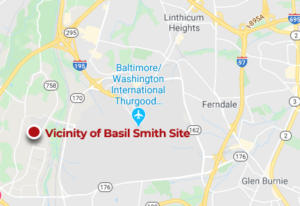 The Basil Smith Farmstead
The Basil Smith Farmstead
The Basil Smith farmstead was located on land that is now part of Baltimore/Washington International (BWI) Airport, the nation’s fastest growing airport. To meet the growing demand for air travel in the Baltimore-Washington metropolitan region, the Maryland Aviation Administration (MAA) has undertaken an accelerated airport improvement program to construct much needed support facilities, such as roadway improvements, terminal gates, and additional parking and rental car facilities. MAA discovered the Basil Smith site during pre-construction field investigations associated with this development.

Background
As the landlord for the more than 3,200 acres that comprise BWI Airport, MAA is also the steward of the many natural resources on its property, such as streams, wetlands, wildlife, as well as its cultural and historic resources. When new development is necessary, MAA must determine the the potential effects of development on these resources and fulfill all applicable laws, including the National Historic Preservation Act. Before MAA chops down a single tree or puts one shovel into the ground, it must determine the potential effects of the project on these resources.
In 2000, MAA began to construct a new rental car facility and parking lots south of the intersection of Stoney Run Road and Ridge Road in Hanover, Maryland. Although the property had been developed previously for residential use, MAA performed extensive field studies, including archaeological studies, to identify evidence of past prehistoric and historic human activities that would be disturbed by construction. MAA archaeologists reviewed archival records and performed an extensive field investigation for more than two years to identify historic cultural resources.
MAA archaeologists identified nineteen sites during their field investigation, but only one site–the Basil Smith site–was considered significant, because it could provide useful information about Maryland’s past. Although MAA tried to minimize adverse effects to archaeological and historical resources associated with this project, it was unable to avoid disturbances to the Basil Smith site. The site was discovered in the middle of the project area, and attempts to shift the proposed development would have affected many natural resources, including wetlands and federally threatened species, as well as other historic cultural resources. To compensate for unavoidable construction impacts to the Basil Smith site, MAA consulted with the Maryland Historical Trust (MHT), performed extensive archaeological excavations, studied the artifacts associated with this former farmstead, submitted the artifacts to the Maryland Archaeological Conservation Lab for curation, and made the results available to the public.

